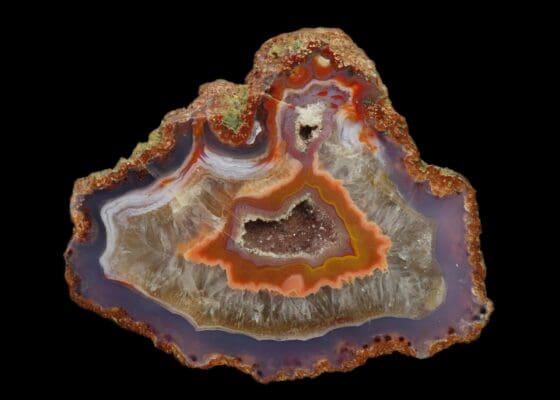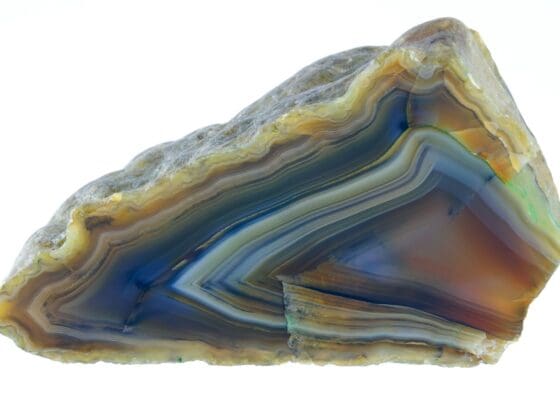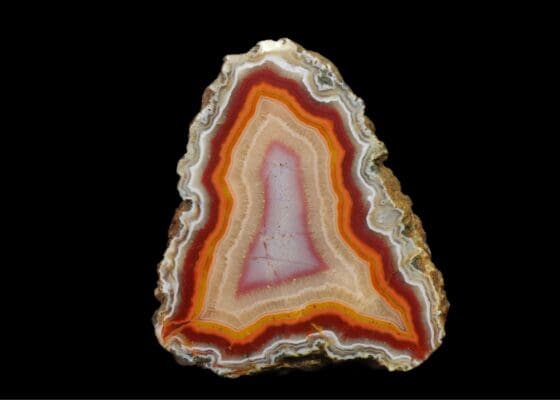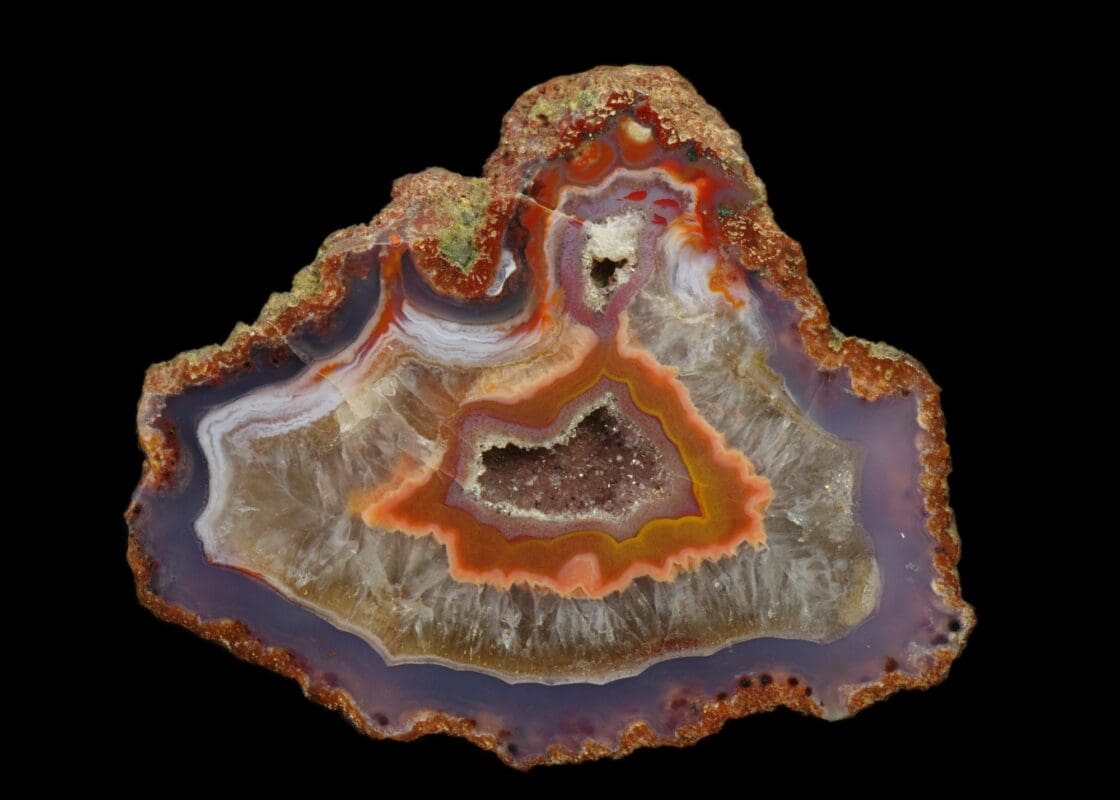Agate Unveiled: Your Ultimate FAQ Guide
Unraveling the Mysteries of Agate Crystals
In the mesmerizing world of gemstones, agate crystals hold a special place, renowned for their intricate patterns, vibrant colors, and unique properties. Agates are not just a visual delight but are imbued with a plethora of qualities that make them a popular choice among collectors, jewelers, and those interested in their metaphysical properties.
A Glimpse into the World of Agate
Agate crystals are a form of chalcedony, characterized by their distinct banding patterns, a result of the slow cooling of silica-rich solutions. Each agate is a unique piece of art crafted by nature, with bands that capture a moment in time, telling a story of the earth’s geological history. They are found in a myriad of colors, each hue unveiling a different characteristic and property.
The Multifaceted Importance of Agates

In Jewelry and Adornment
Agates have been a staple in the world of jewelry for centuries. Their natural beauty, enhanced by their diverse range of colors and patterns, makes them a favorite for artisans and wearers alike. Agate jewelry is not just a fashion statement but is often worn for the stone’s perceived benefits to the wearer’s health and well-being.
In Collecting and Geology
For collectors and geologists, agates are a window into the earth’s past. The bands within agates are akin to the rings of a tree, each layer representing a specific period in geological time. Collecting agates is more than a hobby; it’s a journey through time, with each stone unveiling secrets of ancient epochs.
In Metaphysical and Healing Fields
In the realm of metaphysical healing, agates are revered for their stabilizing and strengthening influences. Each type of agate, be it blue lace agate, moss agate, or fire agate, is believed to possess unique energies that can enhance physical, emotional, and mental well-being. They are often associated with balancing yin and yang energies, instilling harmony, and warding off negative energies.
Basic Understanding of Agate
In the intricate and diverse world of gemstones, agate stands out with its unique banding patterns and a spectrum of colors. Each piece tells a story of the Earth’s magnificent history, offering not just aesthetic pleasure but also a glimpse into the ancient world. Let’s explore the fundamental aspects of this captivating gemstone.

Is Agate a Rock or Crystal?
Agate is a crystal, a variety of chalcedony to be precise, which is a mineral belonging to the quartz family. It is characterized by its microcrystalline structure, which gives it a distinct, often banded, appearance. The formation of agate involves the gradual deposition of silica from groundwater in the cavities of igneous rocks, leading to the unique layered look of these crystals.
Is Agate a Gem Stone?
Yes, agate is considered a gemstone. Its natural beauty, characterized by a variety of colors and patterns, makes it a popular choice for jewelry and decorative items. The process of cutting, polishing, and treating agate reveals the intricate designs and vibrant hues hidden within. Each piece of agate jewelry is a work of art, reflecting the elegance and mystery of nature.
What is Agate Mainly Used for?
Agate has a wide range of uses owing to its beauty and durability. In the realm of jewelry, agate is a favorite for making necklaces, bracelets, rings, and other adornments. Its natural patterns and array of colors offer endless possibilities for unique and attractive designs.
Beyond jewelry, agate is also popular in home décor. Items like agate slices, bookends, and coasters are common. The stone’s natural elegance enhances the aesthetic appeal of any space.
In the metaphysical world, agate is revered for its supposed healing properties. It is believed to bring balance, strength, and positive energy to the wearer. Each type and color of agate is associated with specific healing properties, making it a staple in the world of crystal healing.

Why are Agates so Special?
Agates are special for several reasons. Each stone is unique, with its patterns and colors formed through natural processes over thousands of years. This uniqueness makes every piece of agate jewelry or décor a one-of-a-kind item.
The specialness of agate also lies in its metaphysical properties. Many believe that agates can enhance mental function, improve concentration, and transform negative energies into positive ones. The stone’s grounding energy is said to bring emotional, physical, and intellectual balance.
Furthermore, the durability and versatility of agate make it a favorite among artisans and collectors alike. It’s not just a stone but a piece of Earth’s history, a source of positive energy, and a testament to the mesmerizing beauty that nature bestows upon us.
Identification and Physical Characteristics
Agates, with their mesmerizing patterns and vibrant colors, are a gem enthusiast’s delight. However, identifying and distinguishing them from other similar stones can be a challenge, especially for the uninitiated. In this section, we address some common questions that arise in the process of identifying and understanding the physical characteristics of agates.
How Do You Tell if a Rock is an Agate?
Identifying an agate involves examining its physical characteristics. Agates are typically characterized by their distinct banding patterns, translucency, and a variety of colors. The bands are often concentric and can appear in a myriad of colors, each layer indicating a different period of formation. A true agate is partly translucent – holding it up against a light source should reveal the bands clearly. The surface is often waxy to the touch.
What Do Raw Agates Look Like?
Raw agates are typically rough and may not immediately reveal the beautiful banding patterns that characterize polished agates. They are often found as nodules with a rough, outer surface or as layers within volcanic rocks. When cut open, the intricate bands, diverse colors, and translucency of the agate become visible. The bands can be multi-colored and are usually concentric, following the shape of the nodule.
What is the White Stuff on Agates?
The white stuff on agates is often a layer of chalcedony, another form of quartz. It can also be a result of other minerals that have seeped into the outer layers of the stone over time. This white layer can sometimes cover the beautiful bands beneath, and cleaning or polishing the stone can reveal the colorful patterns hidden underneath.
Do All Agates Have Banding?

While banding is a common characteristic of agates, not all agates have visible bands. Some agates may have faint or irregular banding, while others may exhibit solid colors, mossy inclusions, or other patterns. The presence and visibility of bands can vary greatly, depending on the conditions under which the agate formed.
Is it a Jasper or Agate?
Distinguishing between jasper and agate can be tricky as both are varieties of chalcedony. The primary difference lies in their translucency. Agates are typically translucent to semi-translucent and exhibit banding patterns. In contrast, jasper is opaque and often features homogeneous or spotted colors without distinct bands. Examining the stone’s appearance and translucency can help in identifying whether it’s an agate or jasper.
What Rocks are Mistaken for Agates?
Agates can often be confused with other banded stones like jasper, onyx, or other forms of chalcedony. Rocks with concentric patterns, colorful inclusions, or similar hardness can also be mistaken for agates. It requires a keen eye, and sometimes professional expertise, to distinguish agates from other similar-looking stones, considering the vast variety of patterns and colors that agates can exhibit.
In the world of gemstones, the allure of agates lies not just in their visual appeal but also in the mysteries they hold within their bands – each layer a chapter of the Earth’s geological tale, waiting to be read, admired, and cherished.
Types and Varieties of Agate
Agate, a gemstone known for its diverse patterns and colors, comes in a variety of types, each boasting unique characteristics. This section explores the different types and varieties of agate, offering insights into their distinct features and the natural processes that give rise to their mesmerizing appearances.
What is the Rarest Color of Agate?
Blue agate is considered one of the rarest colors. This enchanting hue is not as commonly found as the reds, browns, and greens that typically characterize these gemstones. Blue agate is highly sought after for its aesthetic appeal and is often associated with tranquility and calmness.
What is a Sugar Agate?

Sugar agate is characterized by its druzy, sugar-like texture. This unique feature is a result of the crystallization of minerals on the surface of the stone, giving it a sparkling appearance. The “sugar” texture adds a dazzling effect to the already beautiful natural patterns of the agate.
What Does a Raw Agate Rock Look Like?
A raw agate rock often has a rough, unpolished exterior that hides the gem’s true beauty. It can be found as nodules with waxy, typically dull surfaces or as layers within host rocks. When split or cut open, the intricate bands, vibrant colors, and translucency of the agate are revealed.
Is Onyx an Agate?
Onyx is a variety of chalcedony, like agate. However, it is characterized by its parallel bands that are contrasting and often black and white. While both onyx and agate have banding, the key difference lies in the pattern and orientation of these bands. Agate bands are concentric and curved, while onyx bands are parallel and straight.
What Does a Blood Agate Look Like?
Blood agate, as the name suggests, features red to reddish-brown hues reminiscent of blood. The coloration is due to the presence of iron oxides within the stone. Blood agate often has a mix of swirling patterns and may include other colors that complement the dominant red tones.
What is Dendritic Agate?

Dendritic agate is known for its distinct tree-like or fern-like inclusions. These inclusions are often black or brown and are formed from manganese or iron oxides. The dendritic patterns create a beautiful contrast against the translucent to opaque background of the agate.
What is Lightning Agate?
Lightning agate is characterized by its striking patterns that resemble bolts of lightning. The intricate, zigzagging lines and vibrant colors create a dynamic visual effect, making each piece unique and highly valued among collectors.
What is a Hydro Agate?
Hydro agate is formed when agate stones are hydrothermally infused with minerals to enhance or change their color. This process can result in vibrant, often unnatural hues that make hydro agates visually striking.
What is Tree Agate?

Tree agate is characterized by its green dendritic patterns against a white or clear background, resembling trees or foliage. It is not banded like other agates and is often associated with inner peace and plenitude.
What is Forest Agate?
Forest agate, similar to tree agate, features green hues and patterns that evoke the richness of a forest. It is often used for its supposed grounding and nurturing energies.
Each type of agate, with its unique characteristics, patterns, and colors, is a testament to the diversity and beauty of nature. These stones, formed over millennia, offer not just visual delight but are also imbued with meanings and energies that many believe can enhance our lives in various ways.
Cleaning and Care of Agates
Proper maintenance is essential to preserve the beauty and integrity of agate stones. Whether you’re a collector, jeweler, or someone who simply admires the natural beauty of agates, knowing how to clean and care for these gemstones is crucial. In this section, we address a common question regarding the cleaning process of agates.
Can You Soak Agates in Vinegar?
Yes, agates can be soaked in vinegar to clean them. However, it should be done with caution. Vinegar is a mild acid that can help remove calcium deposits and other surface impurities without damaging the stone. The soaking time can vary, but it’s essential to monitor the process to ensure that the acid does not affect the stone’s natural color or patterns. After soaking, thoroughly rinse the agate with water to neutralize the acid and then allow it to dry completely.
Value and Worth of Agates
Agates, with their mesmerizing patterns and colors, are not only valued for their aesthetic appeal but also have monetary worth. In this section, we explore the financial value associated with these beautiful stones.

Are Agates Worth Any Money?
The value of agates can vary widely depending on factors like type, color, pattern, size, and overall quality. Rare colors and patterns, such as blue agate or eye agate, can be more valuable. Agates that are skillfully cut and polished to reveal their intricate inner patterns can also fetch a higher price.
Collectors and enthusiasts often value agates for their aesthetic and metaphysical properties, and certain types can be considered collectibles. While they may not be as expensive as some precious gemstones like diamonds or rubies, agates do hold monetary value, especially those of high quality, rare patterns, or colors.
In essence, the worth of an agate is influenced by its rarity, beauty, and demand in the market. Each piece, with its unique patterns and energy, holds a special value to those who appreciate the artistry and mystery locked within these captivating stones.
Locations and Finding Agates
For gemstone enthusiasts and collectors, the thrill of finding agates in their natural settings is unparalleled. These beautiful stones, formed over millennia, are hidden treasures waiting to be discovered. In this section, we explore the locales where you’re most likely to stumble upon these natural wonders.
Where is the Most Common Place to Find Agates?
Agates can be found all over the world, but they are most commonly discovered in areas with volcanic rocks and in certain sedimentary formations. Regions with a history of volcanic activity often house beautiful agates, as they are formed from the silica deposits in igneous rocks. Countries like Brazil, Mexico, and the United States, particularly in states like Arizona, Oregon, and Michigan, are renowned for their abundant agate finds. Beaches, riverbeds, and deserts can also be promising sites for finding these gemstones.
Agate and Chakras
In the world of metaphysical healing, agates are highly valued. Each type and color of agate is believed to resonate with specific energy centers or chakras in the body, promoting balance and healing. Let’s explore the connection between agates and chakras.
What Chakra is Agate?
Agate is often associated with the root chakra, which is located at the base of the spine. The root chakra is connected to feelings of security, stability, and grounding. Agates, with their grounding energy, are believed to stabilize this chakra, promoting a sense of safety and balance. However, different types of agates can also be associated with other chakras, depending on their colors and properties. For instance, blue lace agate is often linked to the throat chakra, supporting communication and expression.

Common Confusions
With the variety of gemstones available, it’s common for enthusiasts to encounter confusion in identifying and distinguishing between them. In this section, we address a common query that arises in the context of agate identification.
Is Chert the Same as an Agate?
Chert and agate are not the same, although they share some similarities. Both are forms of silica and can be found in similar colors and patterns. However, chert is generally more opaque and lacks the banding that is characteristic of agate. Agates are a variety of chalcedony, known for their translucency and beautiful, concentric bands. Chert, on the other hand, is a more homogeneous rock, often used in the past for making tools due to its hardness and flint-like qualities.
Each section of this article is crafted to offer readers insights into the fascinating world of agates, from their origins nestled in the earth’s crust to their spiritual and metaphysical significance. Every question answered unveils another layer of the mystery, drawing readers into the enigmatic allure of these natural gems.

Conclusion
As we draw this comprehensive exploration of agates to a close, we reflect on the key insights and revelations that have emerged through addressing some of the most common and intriguing questions about these gemstones. Each query unraveled a new facet of agates, painting a holistic picture of their physical characteristics, varieties, values, and the mystical aura that surrounds them.
Summarize Key Points
Agates, with their mesmerizing bands and a spectrum of colors, are a testament to the artistic prowess of nature. These crystals, formed from silica deposits in volcanic rocks, are not just visually appealing but are also imbued with metaphysical properties that many believe influence our physical, emotional, and spiritual well-being.
We delved into the various types of agates, each distinguished by unique patterns, colors, and properties. From the rare blue agates to the sparkling sugar agates and the mystical blood agates, each type is a world of wonder in itself. The process of identifying agates, distinguishing them from similar stones like chert and jasper, and understanding their connection to the chakras, adds layers of intrigue to these natural gems.
The value of agates is not just monetary but also lies in their aesthetic and metaphysical appeal. Their presence in various locations around the world, waiting to be discovered by keen eyes, adds an element of adventure to the allure of these stones.
Final Thoughts on the Beauty, Value, and Variety of Agate Crystals
Agates encapsulate the mystique of the natural world. Each stone, with its unique bands, tells a story of the Earth’s geological history, making every piece a unique artifact of the natural world. The variety of agates, from dendritic agates that capture the essence of trees to lightning agates that embody the dynamic energy of a thunderstorm, showcases the diversity of nature’s artistry.
The beauty of agates is not just skin deep. Beyond their visual appeal lies a world of metaphysical properties, with each type of agate believed to resonate with specific energies that can influence our lives. They are not just stones but companions that accompany us on our journey, offering balance, energy, and a connection to the earth.
In the world of gemstones, agates hold a special place. They are a bridge between the tangible and intangible, the seen and unseen, drawing us into a world where the beauty of nature and the energies of the universe converge. Each agate is a masterpiece, a silent witness to the unfolding saga of the Earth, and a bearer of energies that transcend the physical world.

